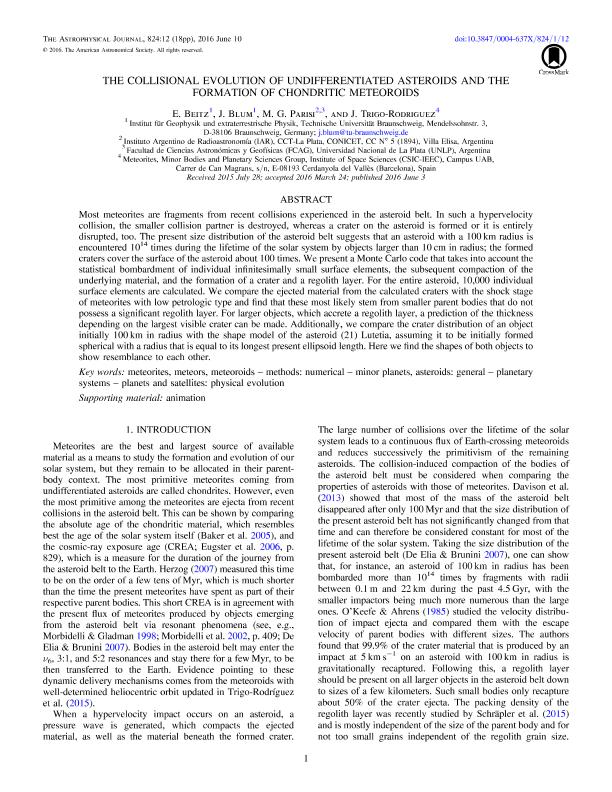Mostrar el registro sencillo del ítem
dc.contributor.author
Beitz, E.
dc.contributor.author
Blum, J.
dc.contributor.author
Parisi, Mirta Gabriela

dc.contributor.author
Trigo Rodriguez, E.
dc.date.available
2017-10-04T14:39:05Z
dc.date.issued
2016-06
dc.identifier.citation
Beitz, E.; Blum, J.; Parisi, Mirta Gabriela; Trigo Rodriguez, E.; The collisional evolution of undifferentiated asteroids and the formation of chondritic meteoroids; IOP Publishing; Astrophysical Journal; 824; 1; 6-2016; 1-18
dc.identifier.issn
0004-637X
dc.identifier.uri
http://hdl.handle.net/11336/25854
dc.description.abstract
Most meteorites are fragments from recent collisions experienced in theasteroid belt. In such a hypervelocity collision, the smaller collisionpartner is destroyed, whereas a crater on the asteroid is formed or itis entirely disrupted, too. The present size distribution of theasteroid belt suggests that an asteroid with a 100 km radius isencountered 10<sup>14</sup> times during the lifetime of the solarsystem by objects larger than 10 cm in radius; the formed craters coverthe surface of the asteroid about 100 times. We present a Monte Carlocode that takes into account the statistical bombardment of individualinfinitesimally small surface elements, the subsequent compaction of theunderlying material, and the formation of a crater and a regolith layer.For the entire asteroid, 10,000 individual surface elements arecalculated. We compare the ejected material from the calculated craterswith the shock stage of meteorites with low petrologic type and findthat these most likely stem from smaller parent bodies that do notpossess a significant regolith layer. For larger objects, which accretea regolith layer, a prediction of the thickness depending on the largestvisible crater can be made. Additionally, we compare the craterdistribution of an object initially 100 km in radius with the shapemodel of the asteroid (21) Lutetia, assuming it to be initially formedspherical with a radius that is equal to its longest present ellipsoidlength. Here we find the shapes of both objects to show resemblance toeach other.
dc.format
application/pdf
dc.language.iso
eng
dc.publisher
IOP Publishing

dc.rights
info:eu-repo/semantics/openAccess
dc.rights.uri
https://creativecommons.org/licenses/by-nc-sa/2.5/ar/
dc.subject
Meteorites
dc.subject
Meteors
dc.subject
Meteoroids
dc.subject
Asteroids
dc.subject.classification
Otras Ciencias Físicas

dc.subject.classification
Ciencias Físicas

dc.subject.classification
CIENCIAS NATURALES Y EXACTAS

dc.title
The collisional evolution of undifferentiated asteroids and the formation of chondritic meteoroids
dc.type
info:eu-repo/semantics/article
dc.type
info:ar-repo/semantics/artículo
dc.type
info:eu-repo/semantics/publishedVersion
dc.date.updated
2017-09-01T18:27:28Z
dc.journal.volume
824
dc.journal.number
1
dc.journal.pagination
1-18
dc.journal.pais
Reino Unido

dc.journal.ciudad
Londres
dc.description.fil
Fil: Beitz, E.. Technische Universität Braunschweig; Alemania
dc.description.fil
Fil: Blum, J.. Technische Universität Braunschweig; Alemania
dc.description.fil
Fil: Parisi, Mirta Gabriela. Universidad Nacional de la Plata. Facultad de Ciencias Astronómicas y Geofísicas; Argentina. Provincia de Buenos Aires. Gobernación. Comision de Investigaciones Científicas. Instituto Argentino de Radioastronomía. Consejo Nacional de Investigaciones Científicas y Técnicas. Centro Científico Tecnológico Conicet - La Plata. Instituto Argentino de Radioastronomia; Argentina
dc.description.fil
Fil: Trigo Rodriguez, E.. Institute of Space Sciences. Campus UAB.; España
dc.journal.title
Astrophysical Journal

dc.relation.alternativeid
info:eu-repo/semantics/altIdentifier/doi/http://dx.doi.org/10.3847/0004-637X/824/1/12
dc.relation.alternativeid
info:eu-repo/semantics/altIdentifier/url/http://iopscience.iop.org/article/10.3847/0004-637X/824/1/12/meta
Archivos asociados
